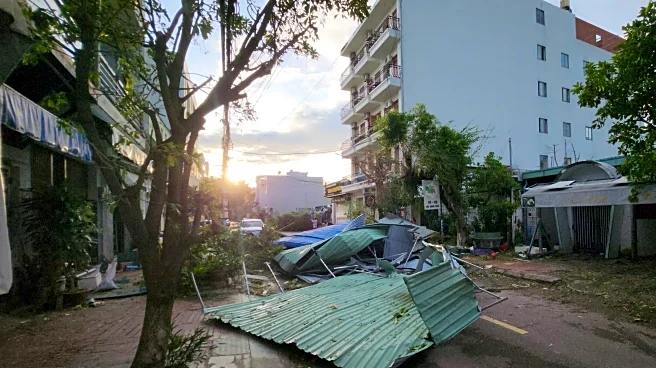What's Happening?
The Philippines is facing a significant threat from Super Typhoon Fung-wong, which is expected to make landfall soon. The typhoon, with winds reaching up to 185 kph and gusts of 230 kph, is approaching
from the Pacific Ocean and is predicted to impact a large portion of the country. In response, nearly a million people have been evacuated from high-risk areas, particularly in northeastern provinces such as Bicol. The typhoon's wide rain and wind band could cover two-thirds of the archipelago, exacerbating the devastation already caused by Typhoon Kalmaegi, which recently resulted in over 224 deaths. President Ferdinand Marcos Jr. has declared a state of emergency, and Defense Secretary Gilberto Teodoro Jr. has urged residents to evacuate from areas prone to flash floods, landslides, and tidal surges.
Why It's Important?
The arrival of Super Typhoon Fung-wong poses a severe risk to millions of people in the Philippines, a country already dealing with the aftermath of Typhoon Kalmaegi. The extensive evacuations highlight the potential for widespread destruction and the need for effective disaster management. The typhoon's impact could disrupt daily life, with schools and government offices preemptively closed and flights canceled. The situation underscores the vulnerability of the Philippines to natural disasters, given its geographical location and frequent exposure to typhoons, earthquakes, and volcanic activity. The international community, including allies like the United States and Japan, may be called upon to assist in recovery efforts.
What's Next?
As Super Typhoon Fung-wong approaches, authorities are bracing for its impact by shutting down schools and government offices and canceling flights. The typhoon is expected to make landfall in Aurora or Isabela province, potentially affecting metropolitan Manila and other densely populated areas. The government is focused on ensuring the safety of its citizens through evacuations and disaster preparedness measures. The aftermath of the typhoon will likely require significant recovery efforts, and the Philippines may seek international assistance to manage the crisis effectively.
Beyond the Headlines
The frequent occurrence of typhoons in the Philippines raises questions about long-term strategies for disaster preparedness and climate resilience. The country's vulnerability to natural disasters necessitates ongoing investment in infrastructure and community education to mitigate risks. Additionally, the role of international aid and cooperation in disaster response highlights the importance of global solidarity in addressing climate-related challenges.













